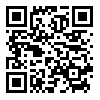year 1, Issue 2 (Summer 2007)
Iran J Med Microbiol 2007, 1(2): 43-48 |
Back to browse issues page
Download citation:
BibTeX | RIS | EndNote | Medlars | ProCite | Reference Manager | RefWorks
Send citation to:



BibTeX | RIS | EndNote | Medlars | ProCite | Reference Manager | RefWorks
Send citation to:
Mirnejad R, Fallahi S, Jeddi F, Kiani J, Taslimi R. Study of spontaneous bacterial peritonitisetiologic agents and determination of their antibiotic resistance pattern. Iran J Med Microbiol 2007; 1 (2) :43-48
URL: http://ijmm.ir/article-1-84-en.html
URL: http://ijmm.ir/article-1-84-en.html
1- Department of Microbiology, School of Medicine,Iran University of Medical Sciences, Tehran , rmirnejad@yahoo.com
2- School of Permedicine, Iran University of Medical Sciences, Tehran
3- Department of Microbiology, School of Medicine,Iran University of Medical Sciences, Tehran
4- Department of virology, School of Medicine, IranUniversity of Medical Sciences, Tehran
5- Emergence Ward Imam Khomeini Hospital, Medical Sciences/University of Tehran
2- School of Permedicine, Iran University of Medical Sciences, Tehran
3- Department of Microbiology, School of Medicine,Iran University of Medical Sciences, Tehran
4- Department of virology, School of Medicine, IranUniversity of Medical Sciences, Tehran
5- Emergence Ward Imam Khomeini Hospital, Medical Sciences/University of Tehran
Abstract: (21689 Views)
Background and objectives: Spontaneous bacterial peritonitis (SBP) is a frequent and often fatal
complication of ascites without a demonstrable intra abdominal cause. In adults, the organisms of SBP are
usually gram-negative bacteria, but they may differin children. Since these organisms are resistant to most
antibiotics, identification of active antimicrobial agents and determination of resistance pattern areessential.
The aim of the present study was also to determine the causative agents of SBP in children with liver disease
and ascites, referred to pediatrics ward of Imam Khomeini hospital during 1384-85.
Material and Methods: In this study, ascite samples were taken from 85 patients with liver disease and ascites of Emam Khomeini Hospital, pediatrics ward, and they were examined by direct test, culture on different media and biochemistry tests. Antibiogram tests by disk diffusion were done on each positive sample.
Results: Of 85 examined samples, 32 bacterial and 2 yeast agents were isolated. Of bacterial cases, Escherichia coli (31.25%) and coagulase negative Staphylococci (18.75%) were the most isolated agents and the rest, included Streptococci and Enterobacteriaceae. Moreover, antibiogram tests identify that most of coagulase negative Staphylococci isolates as resistant to cotrimoxazol, amoxicillin, penicillin and cephalosporin (first generation). The most of gram negative isolated bacteria were resistant to amikacin, vancomycin and gentamicin.
Conclusion: Since the spontaneous bacterial peritonitis is not detectable by clinical signs, ascite samples should be examined in order to determine the etiologic agents. In general spontaneous bacterial peritonitis agents are mostly composed of normal flora bacteria, in our study most isolated bacteria were Escherichia coli and coagulase negative staphylococci, two major normal flora of gastrointestinal tract and skin. The isolated bacteria showed a high antibiotic resistance against common drugs in our study. In general, this study showed that the major agents of spontaneous bacterial peritonitis should be identified by ascite examination and antibiogram test to establish a perfect treatment pattern in order to treat the patients rapidly.
Material and Methods: In this study, ascite samples were taken from 85 patients with liver disease and ascites of Emam Khomeini Hospital, pediatrics ward, and they were examined by direct test, culture on different media and biochemistry tests. Antibiogram tests by disk diffusion were done on each positive sample.
Results: Of 85 examined samples, 32 bacterial and 2 yeast agents were isolated. Of bacterial cases, Escherichia coli (31.25%) and coagulase negative Staphylococci (18.75%) were the most isolated agents and the rest, included Streptococci and Enterobacteriaceae. Moreover, antibiogram tests identify that most of coagulase negative Staphylococci isolates as resistant to cotrimoxazol, amoxicillin, penicillin and cephalosporin (first generation). The most of gram negative isolated bacteria were resistant to amikacin, vancomycin and gentamicin.
Conclusion: Since the spontaneous bacterial peritonitis is not detectable by clinical signs, ascite samples should be examined in order to determine the etiologic agents. In general spontaneous bacterial peritonitis agents are mostly composed of normal flora bacteria, in our study most isolated bacteria were Escherichia coli and coagulase negative staphylococci, two major normal flora of gastrointestinal tract and skin. The isolated bacteria showed a high antibiotic resistance against common drugs in our study. In general, this study showed that the major agents of spontaneous bacterial peritonitis should be identified by ascite examination and antibiogram test to establish a perfect treatment pattern in order to treat the patients rapidly.
Type of Study: Original Research Article |
Subject:
Antibiotic Resistance
Received: 2013/11/11 | Accepted: 2013/11/11 | ePublished: 2013/11/11
Received: 2013/11/11 | Accepted: 2013/11/11 | ePublished: 2013/11/11
Send email to the article author
| Rights and permissions | |
 |
This work is licensed under a Creative Commons Attribution-NonCommercial 4.0 International License. |





